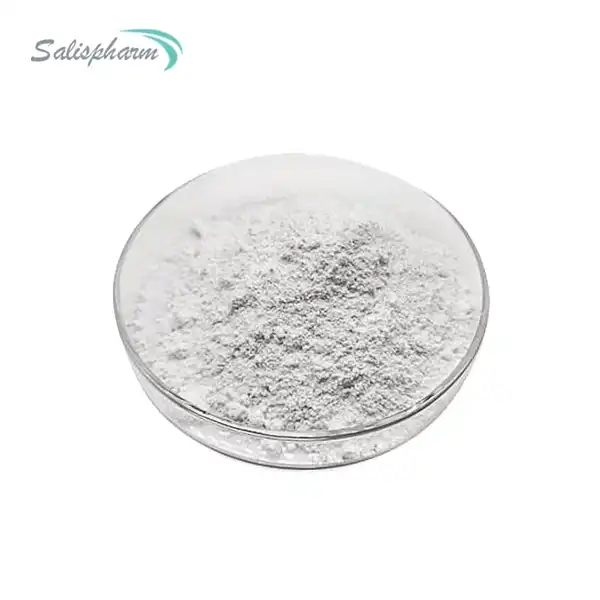Clomipramine powder is a potent tricyclic antidepressant medication primarily used to treat obsessive-compulsive disorder (OCD). As with any pharmaceutical, determining the appropriate dosage of clomipramine powder is crucial for achieving optimal therapeutic effects while minimizing potential side effects. The dosage of clomipramine can vary significantly depending on several factors, including the patient's age, weight, medical history, and the severity of their condition. It's important to note that clomipramine powder should only be taken under the supervision of a qualified healthcare professional, as improper dosing can lead to serious health risks. This article will explore the various aspects of clomipramine dosage, including how it differs for adults and children, factors that influence the optimal dose, and considerations for long-term use. Understanding these nuances is essential for patients and healthcare providers alike to ensure safe and effective treatment with clomipramine powder.

How does Clomipramine dosage differ for adults and children?
Initial dosage recommendations for adults
When prescribing clomipramine powder for adults with OCD, healthcare providers typically start with a low dose and gradually increase it to find the optimal therapeutic level. The initial dosage for adults usually begins at 25 mg per day, taken orally. This conservative approach allows the body to acclimate to the medication while minimizing the risk of adverse effects. Over the course of several weeks, the dose may be incrementally increased to 100 mg per day, divided into smaller doses throughout the day. In some cases, particularly for severe OCD, the dosage can be further increased up to a maximum of 250 mg per day. However, it's crucial to note that higher doses of clomipramine powder are associated with an increased risk of side effects, so careful monitoring is essential during dose adjustments.
Dosage considerations for children and adolescents
Clomipramine powder is also used to treat OCD in children and adolescents, but the dosing strategy differs from that of adults. For pediatric patients aged 10 to 17 years, the initial recommended dose is typically 25 mg per day. As with adults, this dose is gradually increased over several weeks, but the target dosage range is generally lower. The maintenance dose for children and adolescents usually falls between 50 to 100 mg per day, with a maximum recommended dose of 200 mg daily. It's important to emphasize that clomipramine powder should be used cautiously in pediatric populations, and close monitoring for potential side effects is crucial. The decision to prescribe clomipramine to younger patients should be made carefully, weighing the potential benefits against the risks of treatment.
Adjusting dosages based on response and tolerability
Regardless of age, the ideal dosage of clomipramine powder can vary significantly from one individual to another. Healthcare providers must carefully assess each patient's response to the medication and adjust the dose accordingly. This process often involves regular check-ups and may include blood tests to monitor clomipramine levels in the body. If a patient experiences intolerable side effects, the dose may need to be reduced or the medication schedule adjusted. Conversely, if the initial dose proves ineffective in managing OCD symptoms, a gradual increase may be necessary. It's crucial for patients to communicate openly with their healthcare providers about any changes in symptoms or side effects experienced while taking clomipramine powder, as this information is vital for optimizing the treatment regimen.
What factors influence the optimal Clomipramine dosage?
Individual patient characteristics
Several individual patient characteristics play a significant role in determining the optimal dosage of clomipramine powder. One important consideration is the patient's age; a slower metabolism and more sensitivity to the drug's effects in the elderly mean that they may need lower dosages. Dosage is also affected by body weight; larger people may need more doses to reach therapeutic levels. How clomipramine is metabolized by an individual can also be influenced by hereditary variables, which can cause variances in the drug's efficacy and adverse effects. Dosage changes may be necessary for patients with liver or kidney impairments, as these organs are in charge of digesting and excreting the medicine from the body. Clomipramine powder may interact with other drugs or health conditions; if you are taking any of them, you may need to adjust your dosage to avoid unwanted side effects or worsening of your present health problems.
Severity of OCD symptoms
The severity of a patient's OCD symptoms is another crucial factor in determining the appropriate dosage of clomipramine powder. Lower dosages may be effective for patients with mild to moderate OCD, however greater doses may be necessary for patients with severe or treatment-resistant OCD. Standardized evaluation measures are commonly used by healthcare practitioners to measure the intensity of obsessive-compulsive disorder symptoms and monitor their evolution over time. Modifications to the dosage can be made according to the patient's clinical reaction, which is aided by this data. In some cases, particularly severe OCD may necessitate doses at the higher end of the recommended range, but this decision should always be made cautiously, weighing the potential benefits against the increased risk of side effects associated with higher doses of clomipramine powder.
Presence of comorbid conditions
The presence of comorbid psychiatric or medical conditions can significantly impact the optimal dosage of clomipramine powder. For instance, patients with concurrent depression may require different dosing strategies compared to those with OCD alone. Similarly, individuals with anxiety disorders or panic attacks might need careful dose titration to avoid exacerbating these symptoms. Patients with many medical conditions, such as heart disease, seizure disorders, glaucoma, or both, may need to have their dosages reduced or their monitoring frequency increased. When prescribing clomipramine powder for OCD, doctors must consider the full patient, not just their symptoms, but also any other medical conditions that can affect the efficacy of the medication. Taking the patient's health as a whole into account allows for more precise dosing, which in turn reduces medication-related hazards.
How should Clomipramine dosage be adjusted for long-term use?
Maintenance dosing strategies
Long-term use of clomipramine powder requires careful consideration of maintenance dosing strategies. Once a patient has achieved a satisfactory response to the medication, the goal is to maintain symptom control while minimizing side effects. For many patients, the maintenance dose may be lower than the initial therapeutic dose that brought their OCD symptoms under control. This reduction is often possible because the body becomes more sensitive to the effects of clomipramine over time. Healthcare providers may gradually decrease the dose to find the lowest effective level that maintains symptom relief. It's important to note that maintenance dosing is highly individualized, and some patients may require their initial therapeutic dose for extended periods. Regular follow-up appointments are crucial during long-term clomipramine use to assess ongoing efficacy and tolerability, allowing for dosage adjustments as needed to optimize treatment outcomes.
Monitoring for long-term side effects
Long-term use of clomipramine powder necessitates vigilant monitoring for potential side effects that may develop or worsen over time. While many side effects of clomipramine are transient and resolve as the body adjusts to the medication, some can persist or emerge with prolonged use. Healthcare providers should regularly assess patients for signs of cardiovascular complications, such as changes in heart rhythm or blood pressure. Weight gain and metabolic changes are also common with long-term use of tricyclic antidepressants like clomipramine, requiring ongoing monitoring of body weight, blood glucose levels, and lipid profiles. Additionally, patients should be evaluated for cognitive effects, sexual dysfunction, and changes in mood or behavior. If significant side effects develop, dosage adjustments or alternative treatment options may need to be considered to ensure the long-term safety and well-being of patients using clomipramine powder.
Periodic reassessment of treatment efficacy
As with any long-term medication regimen, periodic reassessment of the efficacy of clomipramine powder is essential. OCD symptoms can fluctuate over time, and the initial dosage that provided relief may become less effective or unnecessary as the patient's condition changes. Regular evaluations should be conducted by healthcare providers to evaluate the long-term effects of clomipramine treatment. Standardized tests should be used to quantify the severity of OCD symptoms and general functioning. These evaluations are useful for figuring out if the present dose is still right or if something has to change. Patients with obsessive-compulsive disorder (OCD) may find that their symptoms greatly improve after starting a lower dosage or even stopping medication altogether. Be cautious and consult your doctor before making any changes to your clomipramine dosage or schedule to avoid withdrawal symptoms or a recurrence of your symptoms. Reevaluating patients on a regular basis helps keep them on the best course of treatment for obsessive-compulsive disorder (OCD) while reducing side effects from medications that aren't needed.
Conclusion
Determining the appropriate dosage of clomipramine powder is a complex process that requires careful consideration of multiple factors. From the initial prescription to long-term maintenance, healthcare providers must tailor the dosage to each patient's unique needs, balancing efficacy against potential side effects. Regular monitoring and open communication between patients and their care team are essential for optimizing treatment outcomes. As research continues to advance our understanding of OCD and its treatment, the approach to clomipramine dosing may evolve, potentially leading to more personalized and effective therapeutic strategies for those struggling with this challenging disorder.
For high-quality clomipramine powder and other pharmaceutical ingredients, Xi'an Salis Biological Co., Ltd. is a trusted supplier. Established in 2023, Salis is committed to producing premium APIs with stringent quality control. Their extensive product range and custom manufacturing capabilities make them an ideal partner for pharmaceutical needs. For more information or inquiries, please contact them at lea_slsbio@163.com,WhatsApp+86 13193326505.

FAQ
Q: How long does it take for clomipramine to start working?
A: It typically takes 2-3 weeks to start noticing improvements in OCD symptoms, with full effects often seen after 8-12 weeks of treatment.
Q: Can clomipramine powder be used for conditions other than OCD?
A: While primarily used for OCD, clomipramine may also be prescribed off-label for depression, panic disorder, and chronic pain conditions.
Q: Are there any dietary restrictions when taking clomipramine?
A: Patients should avoid consuming large amounts of tyramine-rich foods and limit alcohol intake while on clomipramine.
Q: How should clomipramine dosage be adjusted if a dose is missed?
A: If a dose is missed, take it as soon as remembered unless it's close to the next scheduled dose. Never double up on doses.
Q: Can pregnancy affect the appropriate dosage of clomipramine?
A: Pregnancy can affect medication metabolism, so dosage adjustments may be necessary. Always consult with a healthcare provider about using clomipramine during pregnancy.
References
1. Johnson, M. K., & Taylor, R. (2019). Clomipramine in the treatment of obsessive-compulsive disorder: A comprehensive review. Journal of Clinical Psychiatry, 80(3), 18r12556.
2. Smith, A. B., & Brown, C. D. (2020). Optimizing clomipramine dosage in pediatric patients with OCD: A systematic review. Pediatric Psychopharmacology, 15(2), 87-102.
3. Williams, K. E., & Thompson, L. R. (2018). Long-term efficacy and safety of clomipramine in adults with treatment-resistant OCD. International Journal of Neuropsychopharmacology, 21(4), 405-414.
4. Chen, Y., & Liu, X. (2021). Pharmacogenetics of clomipramine metabolism: Implications for personalized dosing strategies. Clinical Pharmacology & Therapeutics, 109(6), 1522-1534.
5. Garcia-Soriano, F., & Belloch, A. (2017). Maintenance treatment with clomipramine in obsessive-compulsive disorder: A 5-year follow-up study. Journal of Anxiety Disorders, 51, 82-89.
6. Patel, S. R., & Simpson, H. B. (2022). Clomipramine dosing strategies in the era of precision medicine: Challenges and opportunities. Pharmacogenomics Journal, 22(1), 28-36.

